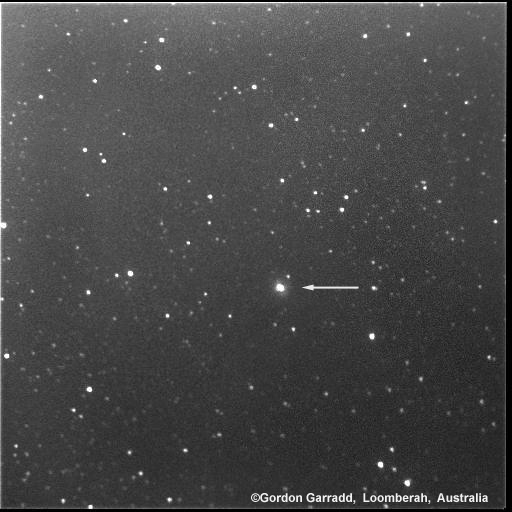
Nova Cen 2001 (image kindly provided by Gordon Garradd)
In this section we will introduce some stories related to the world of astronomy. If you have an interesting experience you would like to share with us, feel free to contact us!
21 Oct. 2001. This month we present the fascinating experience of William Liller, Chile, who discovered a Nova in Cen (V, ). Than you, Bill, for preparing this note for us.
-----------------
"Chilean women are dangerous! I met an attractive widow in 1979, couldn't
resist her charms, and moved in with her in 1981. We live on the north
edge of Vina del Mar less than a kilometer from the Pacific shore at
latitude 33.0 degrees South which means that Sagittarius and the center of
the Milky Way Galaxy pass right through the zenith. In our late winter and
spring, July through November, it is an imposing sight. Coastal fog,
frequent especially after midnight, hampers observing, but my major problem
is the light pollution from the nearby cities of Vina del Mar and
Valparaiso with a total population of nearly a million. My naked-eye
magnitude limit now is about 4.5.
But the center of the Milky Way is where most of the novae occur and I
couldn't resist its charms. And so in 1982 I began taking routine
photographs of the southern Milky Way with fine-grain Kodak Technical Pan
film, a Nikon camera, and an 85mm f/1.4 lens -- from Aquila to Vela. To
reduce the light pollution and because most novae have strong emission from
the red hydrogen (alpha) line, I also use an orange filter.
To compare each new photograph with an archival one, I use a stereoscopic
viewer made of two 25x macroscopes. When something appears on one film but
not the other, something "clicks" in the brain and says that something odd
is happening. It takes a little practice, but it seems to work fine.
People keep asking me why I still take photos and not use a CCD. The
answer is simply that to have the computer power needed to analyze all the
images would be very, very expensive.
It took awhile to refine the search procedure, but in January I found my
first, Nova Muscae -- and then new discoveries started coming at a rate of
about two a year. My latest discovery, Number 36, Nova Centauri, was made
on the evening of September 30 - October 1 of this year. The weather
during all of September had not been good, and at last there was a
spectacularly beautiful night sky. Even though the moon was only one day
from being full, I was able to take photographs with only slightly reduced
exposure time.
A more serious problem was that at 1 pm Oct. 1, I had to leave to catch a
plane to the USA where I was going to attend a conference. Consequently, I
had to be especially efficient to do my searching and be on my way.
It was about 11:30 am on Oct. 1 when my brain clicked and told me something
was on the new photograph of Centaurus that was not on the old one taken a
few weeks earlier. After checking the GCVS and Project Pluto's Guide 7.0,
I convinced myself that this 8.6 magnitude newcomer was very probably a
nova, and after estimating the position to about +/- 1 arcminute, I sent
e-mails to Daniel Green, Taicho Kato, and to amateurs in New Zealand,
Australia and South Africa asking for independent confirmation. It came
fast with my good friends Albert Jones and Andrew Pearce being the first
ones to verify the object. And as I write, it is, I am told, about 12th
magnitude.
But the directors of the IAU Circulars insist that before a nova can
officially be called a nova, there must be three pieces of information: an
independent confirmation, an accurate position, and a spectrum. IAUC 7727
gives the accurate position, and since returning from the USA I have been
trying to get a spectrum. Finally the clouds thinned out, and on Oct. 13
with a CCD and an objective prism on my 20-cm Schmidt camera, I got one.
The star shows a very intense H-alpha emission line approximately 24 times
brighter than the surrounding continuum. H-beta is also present but at
only 2 percent the brightness of H-alpha, demonstrating that the object is
highly reddened, as one would conclude from Gilmore's observation (IAUC
7726) that B-V=+1.41.
Voila! It is officially a nova!"
William Liller
Back to the story of the month